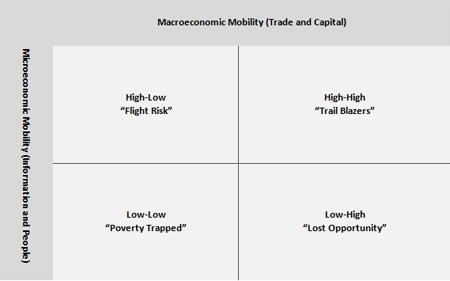One of the key structural drivers of economic performance is economic openness, which measures the connectedness and mobility of economies and which comes about through international trade, capital flows and the movement of information and people. Achieving higher economic openness is a positive force in play that holds great promise for the subcontinent.
From lagging developed markets, sub-Saharan Africa (SSA) has played catch-up over the past 15 years. The region has shown annual real GDP growth some 2% p.a. ahead of global growth. This, combined with structural reforms taking place in the subcontinent - which include governance and policy improvements, debt retirement and material political reforms - has yielded a region rich with opportunity. That this coincides with an era of advanced world structural decay only serves to highlight the potential of Africa. By contrast, the historically economically advanced Western world has succumbed to the four macroeconomic demons of excessive debt, demographic decay, deep-rooted unemployment and deficient policy.
As intimated, at least four clear drivers can be identified as having contributed to SSA's surge, including:
- Higher demand for commodities associated with the dynamic rise of new markets, which, in turn, supports substantial price increases that remain elevated;
- Debt relief and sustained fiscal improvement, evidenced by Africa's debt-to-GDP ratio having more than halved from around 70% in 1990 to 30% today (amongst the lowest in the world);
- Better economic management and policy platforms - for example Africa's institutional strength and competitiveness scores in the World Economic Forum's Global Competitiveness Report have steadily improved since 2006; and
- Africa's demographic dividend, represented by the world's fastest growing, urbanising population, with access to ever-improving health care, education and technology.
The impact on economic growth has been significant and tangible, which, in turn, has given birth to great business opportunities and wealth creation. Notably, in the last decade SSA's economic growth has become of increasingly higher quality. For instance, whilst resources continue to matter to the region's economies, their importance has diminished as a gradual but persistent shift towards the secondary and tertiary sectors has taken place on the continent, and this is where the greatest opportunity arguably resides in mobility and connectedness. On a macroeconomic level, we refer to the mobility of goods, services and capital, which facilitates the production process. On the microeconomic level, the mobility of information, knowledge, technology and people contributes to the rising productivity of those factors.
We can plot these two metrics on a matrix, as shown in Chart 1:
Chart 1: Macroeconomic Mobility (Trade & Capital) vs Microeconomic Mobility (Information & People)
Against this backdrop, and drawing on a large body of international evidence, Cannon Asset Manager's research team has developed a framework for modelling connectedness. The model recognises four forms of connectedness, namely:
- "Poverty Trapped" economies, such as North Korea today or former Soviet economies, with low macroeconomic and macroeconomic mobility. This is where SSA has been located historically;
- "Lost Opportunity" economies, where the macroeconomic factors of goods, services and capital enjoy increasing mobility but microeconomic factors battle to get across borders. Brazil in the 1980s is an example of such an economy;
- "Flight Risk" economies where people and information can move across borders, but goods, services and capital are trapped. In such settings, people tend to "get up and go" following trade and investment opportunities. South Africa in the 1980s is an example of such an economy; and
- "Trail Blazer" economies, which have high mobility in macroeconomic and microeconomic factors. Examples of this type of economy are the Asian tigers, such as Singapore, Hong Kong, Taiwan and South Korea, as well as other "miracle" economies, such as Estonia, Chile and the Czech Republic.
Notably, Africa has spent most of its modern economic history locked in the "poverty trapped" zone, with low mobility in macroeconomic and microeconomic factors. However, this is changing rapidly, albeit from a low base. By way of example, since 2000, 316 million new mobile connections have been made while 31 countries (out of 54) now boast 3G services compared to zero in 2004. Trade with Brazil, Russia, India and China has grown from USD10 billion in 2000 to more than USD200 billion today, and foreign direct investment flows to SSA economies have grown by a factor of 10 times over the same period.
Seen in this light, there is spectacular potential to be derived for Africa from the growing intra-regional links. In addition, inside of economies, connectedness and mobility afford new opportunities. Kenya's M-Pesa is a great case in point. One study estimates that mobile technology has the capacity to add another 10% to SSA's economy as a one-off upward adjustment through applications such as mobile payment, micro insurance and micro lending; smart logistics; traceability and tracking; and agricultural trading, tendering and bartering platforms.
Raising mobility
Arguably, the leverage is remarkable. Our research shows that raising mobility (measured as the average of macroeconomic and microeconomic scores highlighted in the above framework) by just 5% has the potential to add some 40% to the region's GDP.
South Korea offers a superb illustration of the possibilities created by rising mobility and connectedness - and indeed what to anticipate. Per capita income in the Asian state soared from USD80 in 1960 to USD23 000 in 2012. Notably, these gains were driven more by connecting to neighbours, such as Japan, Taiwan and China, than to the world at large. Perhaps economies such as Kenya, Uganda, Rwanda, Tanzania and Ghana find themselves at the same point as South Korea 40 years ago. This potential, where huge opportunity for economic advance resides in connectedness, competitive growth, increasing sophistication and innovation - enhanced by embracing neighbours - sets up a cycle of growth and prosperity.
As investors, it is always important to bear in mind that, whilst the African economy is poised to benefit from the influence of connectedness and openness, this will not mean that all companies will benefit equally. Investing is not the result of buying businesses exposed to fast growth, but rather paying a good price for a good business, ideally resident in an enabling environment. Seen in this light, we are of the view that exceptional opportunity resides in investing in companies that are engaged in enabling, facilitating and enhancing economic connectedness and mobility in SSA.
































